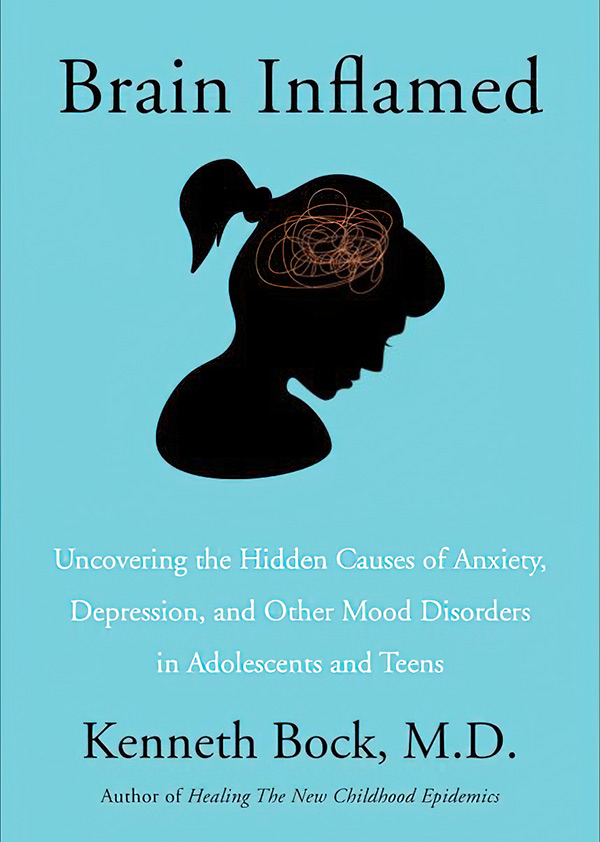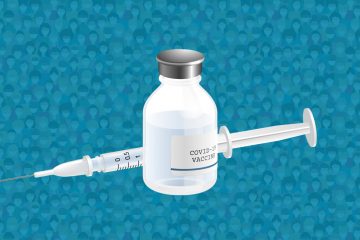“Brain Inflamed” Talks to Parents of Teens with Mental Health Problems Neuropsychiatric symptoms might actually have physical roots.
B y the time they turn 18, as many as 50 percent of all children and teens will meet the diagnostic criteria for at least one mental health disorder.

So says Dr. Kenneth Bock, who has practiced integrative medicine in New York state for 35 years. During much of that time, he has focused on the needs of tweens and teenagers.
If you are a parent or family member of a young person suffering from what appears to be mental health problems, he urges you to remember this: “Not all conditions that present as psychological disorders are actually psychological disorders.”
In fact, he’s been able to help children and teenagers overcome such issues as anxiety, low energy, depression, emotional volatility, and behavior disorders by addressing the physical root causes of the conditions—too often overlooked by conventional approaches.
He shares this knowledge in his new book BRAIN INFLAMED: Uncovering the hidden causes of anxiety, depression, and other mood disorders in adolescents and teens.
As he states in his introduction, I’ve often found that a panic disorder is being caused by something no one has thought to investigate, like an immune system gone haywire, or low blood sugar, or an out-of-whack adrenal system. With proper treatment that addresses the source of the symptoms, these children’s neuropsychiatric issues—the violent mood swings, brain fog, lethargy, anxiety, depression, tics and OCD—can lessen and even disappear.
Range of conditions
 The book introduces a concept Dr. Bock calls the Mood Dysregulation Spectrum. This term illustrates the vast range of conditions that can manifest as neuropsychiatric symptoms but might actually have physical origins. Examples of such causes include gluten sensitivity, adrenal dysfunction, or infections such as Lyme disease and strep.
The book introduces a concept Dr. Bock calls the Mood Dysregulation Spectrum. This term illustrates the vast range of conditions that can manifest as neuropsychiatric symptoms but might actually have physical origins. Examples of such causes include gluten sensitivity, adrenal dysfunction, or infections such as Lyme disease and strep.
Notes Dr. Bock: “Being aware that there are multiple medical conditions that could contribute to your child’s condition is the first step toward getting them better.”
The book begins with an introduction to how the immune system works. Thus, we learn how inflammation can start in one part of the body, such as the gut, and then wreak havoc on a different part of the body, like the brain. Dysbiosis—an imbalance of intestinal flora—in fact can lead to a wide variety of problems, both physical and mental.
Sometimes inflammation leads to an autoimmune reaction in the brain—often called PANDAS or PANS—which can seemingly turn a child into a completely different person overnight. This illness can involve a terrifying constellation of symptoms, including the rapid onset of obsessive-compulsive behaviors, severe anxiety, mood swings, aggressiveness, and other abnormalities.
With proper treatment that addresses the source of the symptoms, these children’s neuropsychiatric issues—the violent mood swings, brain fog, lethargy, anxiety, depression, tics and OCD—can lessen and even disappear.
Dr. Bock proposes a new name for the condition: infection-triggered autoimmune brain inflammation, or ITABI. (I heartily agree with Dr. Bock on this. Neither PANS nor PANDAS mentions inflammation—one of the hallmarks of the condition. And PANDAS only refers to strep—too restrictive a definition for an illness with so many contributing factors.)
Mood Dysregulation Spectrum
The author delves into a variety of situations that can thrust a young person onto the Mood Dysregulation Spectrum—such as thyroid and adrenal imbalances, nutritional deficiencies, infections such as Lyme disease and Bartonella, and toxic exposures to mold, lead, or mercury.
One of the most intriguing parts of the book is its use of case studies to demonstrate the complexities of what these young people (and their parents!) have gone through to find answers. One particularly riveting account traces the experiences of Stacy, an adolescent whose myriad problems had started shortly after she was bitten by a tick at age 4.
According to Dr. Bock, the risk of misdiagnosing a case of Lyme disease is especially high in children.
For the next nine years, the girl suffered from panic attacks, periodic rages, severe anxiety, OCD, chronic sinusitis, mood disorder, ADHD, and involuntary jerking of her arms.
Stacy had been tested for Lyme disease a few times—all negative. (But as we in the Lyme community have learned, a negative test doesn’t necessarily mean you don’t have it.)
Stacy’s doctors tried a dozen different heavy-hitting psychiatric drugs on her over the years, to no avail. When her parents finally brought her to Dr. Bock at age 13, he didn’t let those previously negative Lyme tests stop him from investigating the possibility of tick-borne disease.
According to Dr. Bock, the risk of misdiagnosing a case of Lyme disease is especially high in children. “While neuropsychiatric symptoms often accompany the physical symptoms of Lyme disease in adults,” he writes, “they can be the only signs of Lyme disease in kids: irritability, personality change, depression, brain fog, mood disorders, school phobia, insomnia, and anxiety.”
Many Causes
I think it’s important to note that the book’s subtitle refers to the “causes” (plural) of these disorders, not their “cause” (singular). In Stacy’s case, Dr. Bock’s examination and testing found not only Lyme and Bartonella, but strep antibodies, vitamin D deficiency, reactivated Epstein-Barr virus, low thyroid function, and allergy to cats and pollen.
Working from the assumption that some combination of these factors was contributing to Stacy’s physical and mental health issues, he devised a multi-faceted treatment plan. It didn’t happen overnight, but in time, she made substantial improvements on issues that had plagued her for years.
Other case studies in the book highlight thyroid problems, low blood sugar, adrenal dysfunction, allergies, mold, exposure to toxins, food sensitivities, and nutritional deficiencies.
Dr. Bock says one of the most common nutritional deficiencies he sees is methylfolate, especially in patients with mood disorders. Methylfolate, a B vitamin, is needed for building the neurotransmitters responsible for happiness and emotional well-being. Without it, he says, the brain is primed for anxiety and depression.
Author: Dr. Kenneth Bock
BRAIN INFLAMED is geared to the parents of adolescents. And while it’s true that there are special challenges that come with the teenage years, most of the information in this book applies to adults as well. (And younger children, too, for that matter.) If you or any member of your family is struggling with mental health issues, I strongly recommend you get your hands on a copy right away.
An excerpt from Dr. Kenneth Bock’s book
Brain Inflamed
Signs of Brain Inflammation
Stacey’s elementary school years were punctuated by hypervigilance, school phobia, paranoia, fear of contamination, and uncontrollable rages. Together with neurological symptoms, like the foot drag and the tics, and the OCD, all the symptoms and behaviors screamed brain inflammation to me. Here are some of the other clues I observed:
- Chronic infections: In addition to multiple strep infections, Stacey had battled chronic sinusitis since early childhood. So many infections suggested a compromised immune system.
- Food allergies: At some point, a doctor suggested that Stacey had a sensitivity to dairy and possibly egg whites, and sure enough her symptoms improved when she eliminated these foods, as well as gluten, from her diet (though she strayed from this diet once she felt better). Food sensitivities would point to the possibility of a leaky gut, which can cause widespread inflammation. If her symptoms improved once her gut health improved, that would suggest the gut could be a contributing factor in her neurological and psychological symptoms. For as we’ve read, a leaky gut can contribute to a leaky blood-brain barrier, which would put a patient at a higher than average risk for brain inflammation. Increased permeability of the blood-brain barrier would make it easier for inflammatory elements, such as those triggered by Lyme disease, to get into the brain.
- Stalled progress: The temporary nature of Stacey’s improvement after IVIG told me that something was blocking the treatment’s efficacy. Could it be that she wasn’t getting a high enough dose? Typically, low doses of IVIG are used to treat immune deficiency conditions, whereas neurological autoimmunity and brain inflammation require higher doses. Stacey’s first two IVIG treatments, the ones that had worked best, were administered at a high dosage, but perhaps to mitigate her severe headaches, her doctor had lowered the dose for the subsequent ones.
- Dilated eyes: Stacey’s pupils were massive the first time I saw her. Living with chronic anxiety means living in a perpetual state of fight or flight. The sympathetic nervous system is on high alert, and to me, that suggests brain inflammation, as dilated pupils are frequently seen during flares of ITABI. [Also known as PANS/PANDAS.]
- Homicidal thoughts: Though Lyme patients typically report crushing exhaustion, there have been instances of people with Lyme committing violence against others or reporting homicidal or suicidal thoughts.
Co-infections
While ticks are the primary vector for Lyme disease, they frequently carry many other diseases as well, all of which can be transmitted at the same time. In fact, slightly over 50 percent of Lyme disease patients are also diagnosed with at least one co-infection such as Babesia, mycoplasma, or Bartonella.
Lyme disease can be bad; Bartonella can be worse. The same bacteria that causes cat-scratch fever, in which the lymph vessels become inflamed, Bartonella is treated relatively effectively with intracellular antibiotics when caught early. Unfortunately, because it can burrow into red blood cells, it doesn’t always show up in bloodwork. When patients come in with symptoms like numbness or tingling feet, a doctor might test for Lyme, but if the Lyme titer is negative, they’ll assume that whatever is ailing the person can’t be tick-borne.
However, if they haven’t checked the western blot, and they haven’t tested for any of the common co-infections that travel with Lyme disease (which is especially important in patients who come from endemic areas, work with animals, or spend a lot of time outside), it’s premature to rule out tick-borne diseases. And early detection is important; as with Lyme, the longer Bartonella is left in the bloodstream, the harder it is to eliminate.
The most distinguishing symptoms of Bartonella are soreness on the bottom of the feet, especially the heel; ice pick–like pain in and around the eyes; headaches; and violaceous striae, reddish-purplish tracks that look like stretch marks. But it can also cause intense joint pain, GERD, difficulty swallowing, and crawling, burning sensations in the skin. Another symptom of Bartonella is intense, violent anger, sometimes accompanied by homicidal thoughts.
The other co-infections that frequently travel with Lyme have overlapping symptoms. Babesia, however, is a protozoan parasite that invades the brain and nervous system and causes fever, chills, sweats, chest pain, and most notably, air hunger. Mycoplasma, a type of bacteria, can cause severe fatigue, dry cough, and generalized pain. The more co-infections you have, the more complicated it becomes to treat the Lyme disease.
Explosive Reaction
Stacey’s explosive reaction to the ADHD and psych meds could have been caused by a new Bartonella infection if she’d been bitten by another tick. More likely, however, the cause was brain inflammation, which is often what I find in children who don’t respond at all or have adverse reactions to psychiatric meds. ADHD medicines increase dopamine levels. For a kid with brain inflammation, that’s like throwing a lighted match on a vat of gasoline.
Some psychotropic meds are actually anti-inflammatory, which may be one of the mechanisms for their effectiveness in certain patients. Considered along with all of her history, Stacey’s reaction to these medications seemed extremely relevant to me.
If she did have brain inflammation, I had to consider that she could also have an autoimmune problem. Some doctors will say that the symptoms of post-Lyme are residual, that like PANDAS and strep, Lyme disease can provoke a secondary autoimmune problem that persists even when the bacterial infection is gone. That’s the big controversy when discussing persistent Lyme disease: is it a chronic infection, is it an infection with autoimmunity, or is it just a case of autoimmunity?
I think it’s a combination. You can kill the infection and still be left with fragments of dead bacteria that can stimulate the immune system and cause an autoimmune reaction, and at the same time bacteria can instigate molecular mimicry that triggers autoimmunity in genetically susceptible individuals.
In fact, about half of patients with persistent Lyme symptoms, in particular neuropsychiatric symptoms, test positive for antineuronal antibodies—antibodies produced against nerve cells, especially when they break down and release their neural antigens. The presence of these antibodies points to evidence of autoimmune inflammation in the nervous system.
Over several decades, researchers have found emerging links between autoimmune disorders and neuropsychiatric disorders, prompting more investigation into whether a subset of what we currently diagnose as primary psychiatric disorders are in fact autoimmune disorders with psychiatric symptoms.
If I ran a Cunningham panel — a special test that measures the concentration of antibodies present in the blood — and the results revealed elevated antineuronal antibodies, it could indicate that Stacey’s neuropsychiatric symptoms were being caused by an infection-triggered autoimmune reaction, which would also explain why IVIG had helped calm her neuropsych symptoms so dramatically.
Editor’s note: Any medical information included is based on a personal experience. For questions or concerns regarding health, please consult a doctor or medical professional.






























